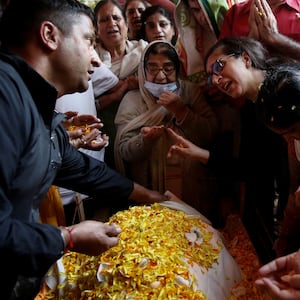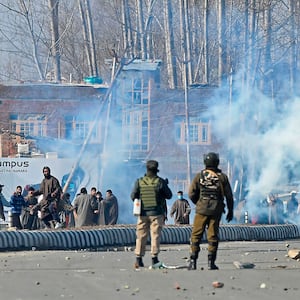NAGALAND, India—“They directly shot at us without a warning,” said 24-year-old Sheiwang Konyak with his right eye shut, lying on a hospital bed where he’s recovering from bullet wounds to his chest and elbow.
He’s one of two survivors of a secret operation carried out on Dec. 4 in the Northeast Indian state of Nagaland, where a team of at least 20 commandos from the Indian Army’s “21 Para Special Forces” gunned down eight civilians “suspected” of being members of a Naga militant group.
In a report seen by The Daily Beast, local police allege they were shot “at random.”
ADVERTISEMENT
Hours laters, seven more civilians were killed in another round of shooting by special forces personnel, when locals from the nearby Oting village showed up to the site of the incident.
The incident sparked fury and local politicians condemned 21 Para’s actions, with one claiming the personnel had “happily shot” at his vehicle bearing the party flag on a separate occasion, killing one of the passengers.

The pickup truck that was ambushed on Dec. 4 in a secret operation based on intel that militants were moving in the area.
Makepeace SitlhouIndia’s home minister, Amit Shah, however, made a statement in parliament in New Delhi claiming the Dec. 4 incident was simply “a case of mistaken identity.”
Referring to the first incident that day, he said that “the vehicle, suspected of carrying insurgents, was fired upon, resulting in killing of six out of eight persons traveling in the vehicle.”
Sheiwang said he was sitting at the back of a pickup truck with five other men from his village when they were suddenly ambushed on the densely forested Oting-Tiru road.
The eight men, all in their twenties and thirties, were returning home after collecting coal from the open cast mines in the village of Tiru which they planned to sell in Assam. Fellow survivor, Yeihwang Konyak, who suffered bullet wounds to his ear and scalp, was unable to speak when The Daily Beast arrived after he underwent a neurosurgical operation three days previously. He was in the passenger seat that day while Shomwang Konyak, 32, the oldest in the group, was gunned down behind the wheel.
“There were several rounds fired at us. All those who were with me at the back of the truck died on the spot,” Sheiwang told The Daily Beast. He recalled hearing three low intensity bombs go off, one of which injured his right eye, before slipping out of consciousness.
The two were being treated in the Assam Medical College and Hospital in Dibrugarh town, where they were reportedly left by Para 21 personnel on Sunday morning. The hospital is roughly 65 miles away from Oting in Nagaland, which shares a borderline with the state of Assam.
Sheiwang’s testimony to The Daily Beast directly contradicts the account of Prime Minister Narendra Modi’s minister, who said the vehicle was signaled to stop before the men attempted to flee from the special forces. “We did not try to flee,” said Sheiwang. “Nor did we have any guns with us”
While the army has announced its own probe, a special investigation team led by the Assistant Director General of Police in Nagaland will conduct its own inquiry this month. The officer in charge of the nearby Tizit police station has lodged an initial report, accusing the 21 Para Special Forces of murder and attempted murder.
A copy of the complaint reviewed by The Daily Beast alleges that since the security forces did not ask local police for a guide, the intention must have been to “murder and injure civilians.”
The incident strikes a particularly ominous note in Nagaland, where there has been a seven-decade insurgency since India gained its independence. More than 16 Naga tribes living in three other states in the region, Manipur, Arunachal Pradesh and Assam, have historically asserted their unique identity from India. Seen as a threat to India’s sovereignty, the demand for separation was brutally suppressed through military operations and later, political talks with various underground groups.
The notorious Armed Forces Special Powers Act (AFSPA) of 1958 gives sweeping powers to Indian armed and paramilitary forces to search, arrest and shoot to kill civilians living in “disturbed areas” merely on suspicion that they might be insurgents.
The Daily Beast found several contradictions with versions put forth by Shah and the Indian army after speaking to survivors of the Dec. 4 massacre and locals in Oting village, as well as intelligence sources and Nagaland State Police.
Expressing regret over the incident, the Indian Army said in a statement that the deadly operation was planned on the basis of “credible intelligence of likely movement of insurgents” in Tiru, in the Mon district of Nagaland.
According to a military intelligence official, the intel was confirmed by a report from the Intelligence Bureau, India’s premier internal security agency, that “eight cadres would be traveling on that road in a white pickup truck.”
A source in the Intelligence Bureau told The Daily Beast that they had received a general intel report in November claiming that the National Socialist Council of Nagalim—Khaplang Yung Aung (NSCN-KYA) were planning attacks along border areas in Arunachal Pradesh and Nagaland. “However, I’m not aware of any such specific [report] being shared by us or any other agency,” the source said. A senior official in Nagaland, who requested anonymity, also told The Daily Beast that there were no specific intelligence reports that KYA were in the area that could have led to this tragedy.
A Nagaland police source, however, did say that an intel report had been made available in the Multi Agency Centre, which is a 24/7 agency for sharing and coordinating intelligence reports, which means the intel should have been accessible or known to the state agencies.
The KYA, which has bases in neighboring Myanmar, is the most radical faction of the Nagaland separatists, and the only group which refused to sign up to a framework agreement with the Indian government in 2015.
Tahwang Angh, the seventh generational traditional head of Oting, said that he’d neither seen nor met any KYA cadres in the village at that time. “After the Konyak Union [the tribal representative body] passed a resolution last year to not pay any taxes until there’s unity among [the underground groups], they have not bothered us,” he told The Daily Beast.

People attend the funeral of civilians killed by Indian army soldiers on Dec. 6, 2021.
Fifi KonyakIn fact, the locals and the Assam Rifles, a paramilitary force formed by the British in the Northeast, whose camps were used by the 21 Para commandos during operations, maintained friendly relations. “The army would openly announce their arrival,” said Tahwang. “We would even offer [the army] water and refreshments”
The shootout had especially troubled the local leader because they’d be in regular touch with the paramilitary, including the intelligence officials. “This is why the attack came as a shock to us,” said Tahwang.
Established in 1826, Oting is a remote village atop scenic mountains considerably cut off from the state capital in Kohima. It is home to more than 1,000 people huddled into about 200 houses. Most of the population is illiterate, according to the 2011 census. It is located in the heart of the heavily neglected Eastern Nagaland, which borders Myanmar, and the local economy is driven by open cast coal mines. The civilians in the pick up truck were local people not migrant laborers, unlike the mix of ethnic communities who come from Assam to work in the coal mines.
“The civilians who died were security guards, small business owners and mostly, church workers, who now and then went to the mines to collect coal from the waste,” said Tahwang, who also owns mines that are leased out to outside contractors.

Angry villagers torched vehicles belonging to Indian security forces from Assam Rifles after 13 civilian were killed by Indian security personnel in an anti-insurgency operation in the northeastern state of Nagaland, India, on Saturday, Dec. 4, 2021.
Caisii Mao/NurPhoto via GettyAnnually, the winter months are peak seasons for extraction before the monsoons arrive, when locals would go to collect the coal scraps for quick cash for Christmas celebrations.
So how did the special forces make such a grave mistake in targeting local people going about their normal business?
Calling the Dec. 4 incident an “intelligence failure” and an “error in judgment on the ground,” a military intelligence source made the case that the army had simply made a mistake, claiming that the men were mistaken for militants because one of the civilians was carrying a hunting rifle, something the survivors deny.
“The surveillance party, which was the first squad on lookout duty, mistook the rifle as a barrel gun and the machetes slung across their chest as weapons,” the source said, adding that the surveillance unit had informed the next squad who were several yards away that a potential target was on its way. Even then, he added, the second squad was unsure of information, so they stepped out on the road to stop the pick up truck.
“When they didn’t stop, that’s when they fired and deflated the tires,” said the source who is privy to the military’s debriefing report on the incident. “But when the civilians started running, that’s when the para commandos fired at them. When they came closer, the security personnel realized their mistake.”
This army account is not supported by other evidence.
The initial report filed by the Director General of Police in Nagaland on Dec. 4, a copy of which was seen by The Daily Beast, said that the eight villagers were “ambushed and killed by security forces (reportedly, 21 Para Special Forces based in Assam) at random, apparently without any attempt for identification.”
Examining the chain of events, an Intelligence Bureau source found it hard to believe the official government and army claim that the civilians could be mistaken for militants.
“[Underground groups] do not move around in a cluster, let alone drive a vehicle on the road,” the source told The Daily Beast. “They mostly walk around in smaller groups, wading through the jungles.” He added: “Looking at the bullet riddled windshield, it’s quite clear that the security forces had fired recklessly without any warning shots, or even deflated the tires first.”
The shooting took place around four miles down a treacherous slope from Oting, on a road that cuts through largely desolate and uninhabited forest.
Three of those killed were cousins of Keapwang Konyak, the leader of the local Students Union who used to teach at the village school. Unlike many of his friends in the village, Keapwang was educated out of state and has become a kind of local spokesman thrust into the glare of the national spotlight in the aftermath of the attack.
He was one of the first people to arrive at the scene after the shooting, and hasn’t found time to process the grief of losing his cousins. His mood visibly oscillates from the shock and trauma of that fateful night to anger at the way—he feels—the Indian government was trying to cover up a second shooting in the aftermath of the original massacre as a “mistake” or an act of “self-defense.”
In the official version, the interior minister claimed angry local villagers had surrounded the special forces team, burnt two vehicles and assaulted the commandos, leading to the death of one and injuring several others. “To disperse the crowd, [Para 21] opened fire, which resulted in the killing of 7 more civilians and injuring some others,” Amit Shah explained.
Keapwang told The Daily Beast that was wrong.
He said he saw the bullet-ridden pickup truck, which was empty, and army personnel hanging around after arriving at the scene of the incident a little after 9 pm. After a brief conversation with the Para 21 personnel, Keapwang said he went to check out another pickup truck parked a little ahead that was covered with a tarpaulin sheet.
“It was much smaller in size so I just placed my hands on the sheet and felt heads and legs. That is when I yelled out, ‘The dead bodies are here’ to the locals in our own dialect,” said Keapwang.
After uncovering the dead bodies of the six young men, the locals became agitated and set fire to the three army vehicles.
Then shots were fired, and Keapwang ran some ways inside the jungle from the road for cover. “I thought they were firing in the air,” said the 32-year-old who had gone completely numb by then, unsure of what triggered the firing or how the lone army casualty was killed. “It lasted for about 10-20 minutes.”

Keapwang Konyak, Oting student union president, hid in the jungle after security force personnel started firing at the mobs that had gathered.
Makepeace SitlhouAfter hearing Keapwang’s cries, another group of village locals started approaching the pickup truck carrying the dead bodies from the other side.
Shangyuh Konyak, who was also at the scene of the protest, told The Daily Beast that the firing started as soon as the locals started unloading the bodies from the pick up truck. “They shot everyone who was on the road, even chased after villagers who had run towards the mines and hutments and killed two people near the trucks,” he said. “They were aiming at our chest, not our legs”
A government source told The Daily Beast that though an officer from the nearby Tizit police station had been dispatched, “they couldn’t do anything” because of “the indiscriminate firing, where people were getting shot and killed.” The source also confirmed that the Assam Rifles had been informed of the first shooting incident hours before the second one began.
According to a Nagaland police report, eyewitnesses “confirm that the special forces personnel opened fire indiscriminately as they fled from the scene towards Assam side even firing in the coal mine hutments on the way.” The report said that villagers saw the special forces loading more bodies in another truck, “apparently with the intention of taking the dead bodies to the base camp.”

Remainders of coal gathered by laborers who have stopped going to work in the mines since the incident.
Makepeace SitlhouThis is where contesting versions collide over whether the special forces personnel had tried to doctor the crime scene, passing off the civilians as militants.
“Some of the bodies had been stripped of trousers, not all and a few were wearing army boots,” Keapwang told The Daily Beast. “I didn’t thoroughly check because after seeing my three cousins on the truck, I went into shock and just sat down in silence for a while.”
The army intelligence source said that the personnel stayed behind, waiting for the police to hand over the bodies for formal proceedings.
“If they wanted to cover up the crime, why would the personnel take two of the injured to the hospital? We’re not denying that we made a mistake or that we killed them but it wasn’t a cold blooded murder,” said the source.
A police official who has served time in the northeast region told The Daily Beast he thought that “what happened in Nagaland was not only a ‘botched operation’ but a failure of taking ownership and responsibility among the agencies.”
“Sharing of prior information before operations by [special forces and the Assam Rifles] has always been uncommon. There’s a lack of unified approach in a state where the SF/AR, the state intelligence and the police operate in isolation,” he said, asking not to be identified.
The incident has also raised the spectre of civilian killings under the Armed Forces Special Powers Act. The chief minister of Nagaland has announced an ex gratia of 5 lakh rupees (approximately $6600) for the families of the deceased and asked for the repeal of the act with the cabinet reviewing the status of “disturbed areas,” which is due for renewal in January 2022. Chief ministers of other states have also joined the fight to end the act.
As far as families in Oting are concerned, AFSPA has already cost them their sons, brothers and husbands, stripping them of their support system and dignity. Excess force allegedly committed by security forces in the past has never received federal sanction for trial in civilian courts. Outcomes of the military court of inquiry, an opaque process, has remained out of reach to the public and judiciary.
Chemwang Konyak—a cancer patient in his fifties—lost his eldest son in the shooting. Wracked with grief, Shomwang’s father repeatedly called out in vain for the dead to be brought back to life. “I didn’t even get to see his face after the post mortem,” he said.
For these families, monetary compensation from the government and Shah’s statement was seen as adding insult to injury. “You know, we can’t buy the dead with the compensation money,” Chemwang told The Daily Beast. “The only thing we want is the killers to be identified so we can ensure justice is served.”









